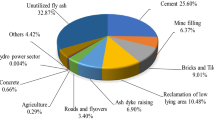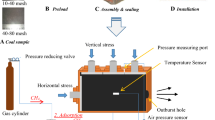Abstract
Failure of in-pit overburden dumps in open-pit coal mines causes debris to flow toward the active working face, threatening the safety of people and equipment. The evaluation of the potential mobility of failing mass will aid in hazard mitigation associated with unwarranted dump failure. The potential mobility is shown by mobility ratio (ratio of total drop between debris flow's initial and final deposition points to total travel distance) and runout characteristics. In light of above, a laboratory-scale debris flow flume was developed to investigate the effect of material gradation and slope angle on runout characteristics and mobility ratio. The total mass of experimental debris mix (Q) is fixed at 30 kg with 20% water content. Experiments at three different slope angles (30°, 35°, and 40°) demonstrate that increasing the proportion of fines in the experimental mix increases runout characteristics while decreasing the mobility ratio. The length and area of the runout decrease as the slope angle increases, while the mobility ratio increases. There is a positive correlation between d50 and runout characteristics at a fines content of 0.1Q, but a negative correlation at a fines content of 0.2Q and 0.3Q. Conversely, there is a negative correlation between d50 and mobility ratio for fines content of 0.1Q, but a positive correlation exists for fines content of 0.2Q and 0.3Q. A new index called the fine-to-coarse (F/C) ratio is used to identify the critical value of fines and coarse proportion that causes a transition from dry granular flow to fluidized debris flow.









Similar content being viewed by others
References
Dawson RF (1994) Mine waste geotechnics. Dissertation, University of Alberta
Robertson AM (1986) Mine waste disposal: An update on geotechnical and geohydrological aspects. In: Geotechnical and Geohydrological Aspects of Waste Management. CRC Press, Taylor & Francis Group, 569
Richards BG, Coulthard MA, Toh CT (1981) Analysis of slope stability at Goonyella Mine. Can Geotech J 18:179–194. https://doi.org/10.1139/t81-023
Ulusay R, Arikan F, Yoleri MF, Çaǧlan D (1995) Engineering geological characterization of coal mine waste material and an evaluation in the context of back-analysis of spoil pile instabilities in a strip mine, SW Turkey. Eng Geol 40:77–101. https://doi.org/10.1016/0013-7952(95)00042-9
Koner R, Chakravarty D (2010) Stability study of the mine overburden dumps slope: a micromechanical approach. Studia Geotechnica et Mechanica 32:35–57
Kainthola A, Verma D, Gupte SS, Singh TN (2011) A Coal Mine Dump Stability Analysis—A Case Study. GM 01:1–13 https://doi.org/10.4236/gm.2011.11001
Poulsen B, Khanal M, Rao AM et al (2014) Mine Overburden Dump Failure: A Case Study. Geotech Geol Eng 32:297–309. https://doi.org/10.1007/s10706-013-9714-7
McDougall S (2017) 2014 Canadian Geotechnical Colloquium: Landslide runout analysis — current practice and challenges. Can Geotech J 54:605–620. https://doi.org/10.1139/cgj-2016-0104
Zhang L, Tang K (2001) Mine debris flow. CA: Beijing
Xu Y, He F, Chen H (2007) Mine debris flow and its distribution in Northwestern China. J Mt Sci 25:729–736
Hungr O, Leroueil S, Picarelli L (2014) The Varnes classification of landslide types, an update. Landslides 11:167–194. https://doi.org/10.1007/s10346-013-0436-y
Iverson RM (1997) The physics of debris flows. Rev Geophys 35:245–296. https://doi.org/10.1029/97RG00426
Cui Y, Zhou X, Guo C (2017) Experimental study on the moving characteristics of fine grains in wide grading unconsolidated soil under heavy rainfall. J Mt Sci 14:417–431. https://doi.org/10.1007/s11629-016-4303-x
Koch T (1998) Testing various constitutive equations for debris flow modelling. IAHS-AISH publication 249–257
Iverson RM (2005) Debris-flow mechanics. Debris-flow hazards and related phenomena 8:105–134
Zhou GGD, Li S, Song D et al (2019) Depositional mechanisms and morphology of debris flow: physical modelling. Landslides 16:315–332. https://doi.org/10.1007/s10346-018-1095-9
Parsons JD, Whipple KX, Simoni A (2001) Experimental Study of the Grain-Flow, Fluid-Mud Transition in Debris Flows. J Geol 109:427–447. https://doi.org/10.1086/320798
Choi CE (2013) Flume and discrete element investigation of granular flow mechanisms and interaction with baffles. Dissertation, The Hong Kong University of Science and Technology
Chalk CM, Peakall J, Keevil G, Fuentes R (2022) Spatial and temporal evolution of an experimental debris flow, exhibiting coupled fluid and particulate phases. Acta Geotech 17:965–979. https://doi.org/10.1007/s11440-021-01265-y
Stancanelli LM, Lanzoni S, Foti E (2015) Propagation and deposition of stony debris flows at channel confluences. Water Resour Res 51:5100–5116. https://doi.org/10.1002/2015WR017116
Rogers CDF, Dijkstra TA, Smalley IJ (1994) Particle packing from an earth science viewpoint. Earth Sci Rev 36:59–82. https://doi.org/10.1016/0012-8252(94)90008-6
de Haas T, Braat L, Leuven JRFW et al (2015) Effects of debris flow composition on runout, depositional mechanisms, and deposit morphology in laboratory experiments: Experimental Debris Flows. J Geophys Res Earth Surf 120:1949–1972. https://doi.org/10.1002/2015JF003525
Moberly D (2015) Laboratory experiments investigating entrainment by debris flows
Cheng YM, Fung WHI, Li L, Li N (2019) Laboratory and field tests and distinct element analysis of dry granular flows and segregation processes. Nat Hazards Earth Syst Sci 19:181–199. https://doi.org/10.5194/nhess-19-181-2019
Hu Y, Li H, Qi S et al (2020) Granular Effects on Depositional Processes of Debris Avalanches. KSCE J Civ Eng 24:1116–1127. https://doi.org/10.1007/s12205-020-1555-3
Ghasemi A (2020) A Study of Particle Entrainment in Two Common Particle-Fluid Flows in Nature: Bedload Transport in Rivers and Debris Flows in Upland Regions
Hu Y, Li H, Lu G et al (2021) Influence of size gradation on particle separation and the motion behaviors of debris avalanches. Landslides 18:1845–1858. https://doi.org/10.1007/s10346-020-01596-z
Rodine JD, Johnson AM (1976) The ability of debris, heavily freighted with coarse clastic materials, to flow on gentle slopes. Sedimentology 23:213–234. https://doi.org/10.1111/j.1365-3091.1976.tb00047.x
Cao Y, Zhu X, Liu B, Nan Y (2020) A Qualitative Study of the Critical Conditions for the Initiation of Mine Waste Debris Flows. Water 12:1536. https://doi.org/10.3390/w12061536
Ryou K, Chang H, Lee H (2021) Laboratory Analysis of Debris Flow Characteristics and Berm Performance. Water 13:2223. https://doi.org/10.3390/w13162223
Take WA, Bowman E, Askarinejad A (2020) Editorial: Physical modelling of landslides. Int J Phys Model Geotech 20:175–176. https://doi.org/10.1680/jphmg.2020.20.4.175
Iverson RM (2015) Scaling and design of landslide and debris-flow experiments. Geomorphology 244:9–20. https://doi.org/10.1016/j.geomorph.2015.02.033
Heim A (1882) Der Bergsturz von Elm. Zeitschrift der Deutschen Geologischen Gesellschaft 34:74–115
D’Agostino V, Cesca M, Marchi L (2010) Field and laboratory investigations of runout distances of debris flows in the Dolomites (Eastern Italian Alps). Geomorphology 115:294–304. https://doi.org/10.1016/j.geomorph.2009.06.032
Mishra S, Tyeb M, Mandal B, Majumder A (2022) Application potential of vibration sensors for online process monitoring of hydrocyclones. Mineral Processing and Extractive Metallurgy Review 1–14
Goren L, Aharonov E, Sparks D, Toussaint R (2010) Pore pressure evolution in deforming granular material: A general formulation and the infinitely stiff approximation. J Geophys Res 115:B09216. https://doi.org/10.1029/2009JB007191
Iverson RM, LaHusen RG (1989) Dynamic Pore-Pressure Fluctuations in Rapidly Shearing Granular Materials. Science 246:796–799. https://doi.org/10.1126/science.246.4931.796
Iverson RM, Logan M, Denlinger RP (2004) Granular avalanches across irregular three-dimensional terrain: 2. Experimental tests: Granular Avalanches Across Irregular Terrain, 2. J Geophys Res 109: https://doi.org/10.1029/2003JF000084
Sulpizio R, De Rosa R, Donato P (2008) The influence of variable topography on the depositional behaviour of pyroclastic density currents: The examples of the Upper Pollara eruption (Salina Island, southern Italy). J Volcanol Geoth Res 175:367–385. https://doi.org/10.1016/j.jvolgeores.2008.03.018
Song D, Ng CWW, Choi CE et al (2017) Influence of debris flow solid fraction on rigid barrier impact. Can Geotech J 54:1421–1434. https://doi.org/10.1139/cgj-2016-0502
Baselt I, Queiroz de Oliveira G, Fischer J-T, Pudasaini SP (2021) Evolution of stony debris flows in laboratory experiments. Geomorphology 372:107431. https://doi.org/10.1016/j.geomorph.2020.107431
Author information
Authors and Affiliations
Corresponding author
Ethics declarations
Competing Interest
The authors declare that they have no known competing financial interests or personal relationships that could have appeared to influence the work reported in this paper.
Conflict of Interest
On behalf of all authors, the corresponding author states that there is no conflict of interest.
Additional information
Publisher's Note
Springer Nature remains neutral with regard to jurisdictional claims in published maps and institutional affiliations.
Rights and permissions
Springer Nature or its licensor (e.g. a society or other partner) holds exclusive rights to this article under a publishing agreement with the author(s) or other rightsholder(s); author self-archiving of the accepted manuscript version of this article is solely governed by the terms of such publishing agreement and applicable law.
About this article
Cite this article
Tiwari, A., Mandal, B.B. & Pathak, K. Influence of material composition on post-failure behavior of overburden dumps in opencast coal mines. Mining, Metallurgy & Exploration 40, 1199–1209 (2023). https://doi.org/10.1007/s42461-023-00773-7
Received:
Accepted:
Published:
Issue Date:
DOI: https://doi.org/10.1007/s42461-023-00773-7




